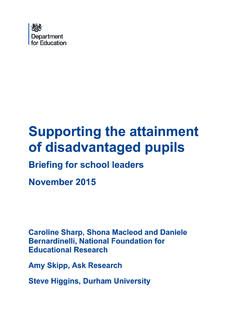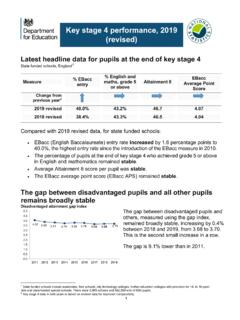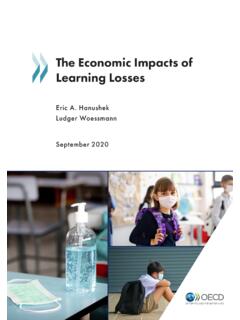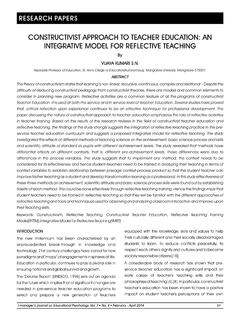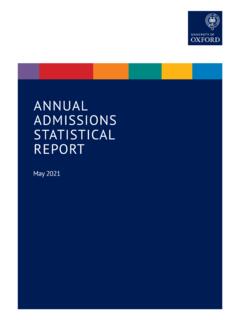Transcription of Education Policy in the UK - ERIC - Education Resources ...
1 EduCEucationStepAnnM EE DP 5 n Policy phen Mana Vigno arch 2057 y in theachin oles 006 e UK ISSN 20455-6557 Published by Centre for the Economics of Education London School of Economics Houghton Street London WC2A 2AE Stephen Machin and Anna Vignoles, submitted December 2005 ISBN 07530 1853 5 Individual copy price: 5 The Centre for the Economics of Education is an independent research centre funded by the Department for Education and Skills. The views expressed in this work are those of the author and do not reflect the views of the DfES. All errors and omissions remain the authors. Executive Summary Throughout the post-war period there have been many attempts to reform the UK Education system.
2 This article reviews empirical evidence looking at the impact of some key reforms which were designed to address a number of specific problems in the UK Education system, namely poor and apparently falling standards in schools, the low staying on rate at age 16, the relatively poor basic skills of the UK population and persistent inequalities in Higher Education . A major concern in the 1980s was that the staying on rate in the UK, although rising, was low by international standards. Furthermore, exam achievement at age 16 had stagnated. This led to widespread concerns about falling standards in schools.
3 In response the Conservative governments of the 1980s and 1990s introduced a number of market mechanisms into the UK Education system, including parental choice, parent representation on governing bodies and linking school funding with student enrolment numbers. Alongside this publicly available test score information was made available with which parents could compare the performance of one school with another. These reforms were designed with an explicit aim to improve pupil achievement. They did, however, raise concerns about increased inequalities in schools. The empirical evidence on the impact of these reforms is patchy.
4 Certainly staying on rates rose for all students and the gap in staying on rates between lower and higher socio-economic group students actually narrowed somewhat after the introduction of these reforms. The evidence on the impact of the reforms on pupil performance however is more mixed. At best it suggests only very limited positive effects of choice and competition on pupil achievement. The second area of concern to policymakers has been the poor basic skills of the UK population, relative to other countries, particularly amongst younger workers. In response the government introduced a standardised national curriculum for all students aged 7-16, in an attempt to ensure that all pupils studied a minimum depth and breadth of curriculum.
5 In the 1990s, a further Policy innovation was introduced, called the literacy and numeracy hours. This prescribed how teachers in primary school should teach at least one hour per day of literacy and numeracy. Again the evidence of the impact of these reforms is not comprehensive. An evaluation of the national curriculum has not been possible since it was introduced nationally. However, there is evidence on the impact of the literacy hour which suggests that it is a cost effective way of improving reading and English achievement. A third problem Policy area has been the relatively small number of pupils staying on in Education past the age of 16 and thus the low proportion achieving level 2 or 3 qualifications, compared to other countries.
6 There have been two major policies introduced to raise UK participation in post compulsory Education . The first is reform of the vocational qualification system, particularly the introduction of new employer focused qualifications such as NVQ and GNVQ, and the revitalisation of apprenticeship in the UK. The second Policy was the introduction of an Education maintenance allowance paid to disadvantaged young people age 16-19 to encourage them to stay on in full time Education . The empirical evidence of the impact of these reforms is mixed. Many of the newer vocational qualifications have very little labour market value, suggesting that they have not been successful in drawing young people into high quality learning that leads to successful labour market outcomes.
7 On the other hand, the new modern apprenticeship scheme that results in a level 3 qualification does have strong labour market value. The evidence on the impact of the Education maintenance allowances is much more positive, indicating that paying a modest allowance does indeed encourage higher participation in Education amongst disadvantaged students. The final Policy area that has been subject to reform in recent decades is higher Education . HE has historically been the preserve of higher socio-economic groups in the UK and, although HE participation has risen substantially in recent decades, the relative position of lower socio-economic groups in terms of HE participation is still poor.
8 The Policy response has been to expand HE further, in an attempt to widen access to previously under-represented groups. However, to finance this expansion tuition fees for HE have been introduced. There are obvious concerns that this will have acted to depress demand for HE among poorer students. In fact the empirical evidence suggests that although there remains a large and widening gap in HE participation between richer and poorer students, this is not necessarily related to the introduction of tuition fees. Furthermore, there is evidence that the Policy of expanding HE has not led to a collapse in the economic value of HE.
9 Indeed the return to a degree has remained high throughout the period. Education Policy in the UK Stephen Machin Anna Vignoles 1. Introduction 1 2. Market Reforms 1 The problem The Policy 3 The evidence 4 3. Curriculum Reform 7 The problem The Policy The evidence 9 4. Raising Participation in Post-Compulsory Schooling 9 The problem The Policy 10 The evidence 11 5. Higher Education Reform 14 The problem The Policy 15 The evidence 16 6.
10 Conclusions 18 References 20 Acknowledgments Stephen Machin is Professor of Economics at University College London, Director of the Centre for the Economics of Education and Research Director at the Centre for Economic Performance, London School of Economics. Anna Vignoles is a Senior Lecturer at the Institute of Education and Deputy Director of the Centre for the Economics of Education .











